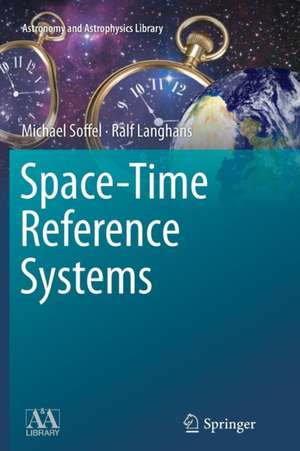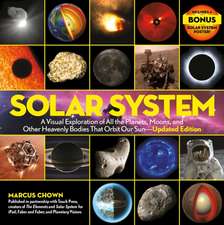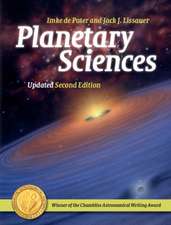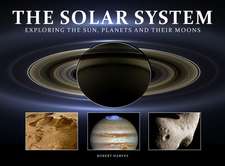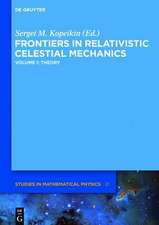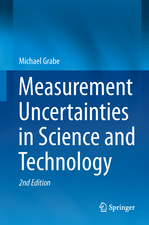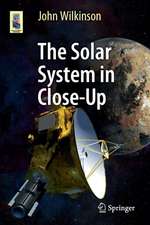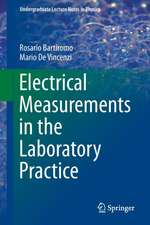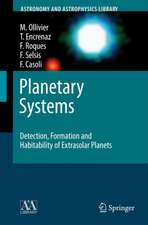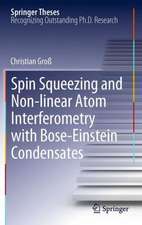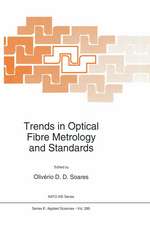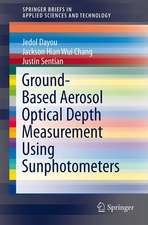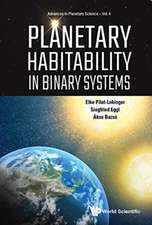Space-Time Reference Systems: Astronomy and Astrophysics Library
Autor Michael Soffel, Ralf Langhansen Limba Engleză Paperback – 9 noi 2014
The topics presented in this book are complemented by exercises (with solutions). The authors offer a series of files, written in Maple, a standard computer algebra system, to help readers get a feel for the various models and orders of magnitude.
Beyond astrometry, the main fields of application of high-precision astronomical spatial-temporal reference systems and frames are navigation (GPS, interplanetary spacecraft navigation) and global geodynamics, which provide a high-precision Celestial Reference System and its link to any terrestrial spatial-temporal reference system. Mankind’s urgent environmental questions can only be answered in the context of appropriate reference systems in which both aspects, space and time, are realized with a sufficiently high level of accuracy. This book addresses all those interested in high-precision reference systems and the various techniques (GPS, Very Long Baseline Interferometry, Satellite Laser Ranging, Lunar Laser Ranging) necessary for their realization, including the production and dissemination of time signals.
| Toate formatele și edițiile | Preț | Express |
|---|---|---|
| Paperback (1) | 390.08 lei 6-8 săpt. | |
| Springer Berlin, Heidelberg – 9 noi 2014 | 390.08 lei 6-8 săpt. | |
| Hardback (1) | 396.40 lei 6-8 săpt. | |
| Springer Berlin, Heidelberg – 18 oct 2012 | 396.40 lei 6-8 săpt. |
Din seria Astronomy and Astrophysics Library
- 17%
 Preț: 496.38 lei
Preț: 496.38 lei - 15%
 Preț: 601.60 lei
Preț: 601.60 lei - 19%
 Preț: 455.25 lei
Preț: 455.25 lei - 17%
 Preț: 525.74 lei
Preț: 525.74 lei - 13%
 Preț: 393.37 lei
Preț: 393.37 lei - 19%
 Preț: 524.15 lei
Preț: 524.15 lei - 17%
 Preț: 393.90 lei
Preț: 393.90 lei - 15%
 Preț: 647.40 lei
Preț: 647.40 lei - 15%
 Preț: 541.54 lei
Preț: 541.54 lei - 17%
 Preț: 362.71 lei
Preț: 362.71 lei - 18%
 Preț: 1006.55 lei
Preț: 1006.55 lei - 18%
 Preț: 745.33 lei
Preț: 745.33 lei - 15%
 Preț: 641.20 lei
Preț: 641.20 lei -
 Preț: 397.38 lei
Preț: 397.38 lei - 15%
 Preț: 598.21 lei
Preț: 598.21 lei - 15%
 Preț: 658.05 lei
Preț: 658.05 lei - 23%
 Preț: 815.09 lei
Preț: 815.09 lei -
 Preț: 409.89 lei
Preț: 409.89 lei - 15%
 Preț: 610.61 lei
Preț: 610.61 lei -
 Preț: 393.90 lei
Preț: 393.90 lei - 15%
 Preț: 655.27 lei
Preț: 655.27 lei - 18%
 Preț: 951.47 lei
Preț: 951.47 lei - 18%
 Preț: 960.42 lei
Preț: 960.42 lei - 18%
 Preț: 1397.68 lei
Preț: 1397.68 lei - 18%
 Preț: 959.98 lei
Preț: 959.98 lei - 18%
 Preț: 1012.08 lei
Preț: 1012.08 lei - 15%
 Preț: 481.03 lei
Preț: 481.03 lei - 15%
 Preț: 672.43 lei
Preț: 672.43 lei -
 Preț: 413.15 lei
Preț: 413.15 lei - 18%
 Preț: 1554.72 lei
Preț: 1554.72 lei - 18%
 Preț: 1410.63 lei
Preț: 1410.63 lei -
 Preț: 390.08 lei
Preț: 390.08 lei - 18%
 Preț: 944.99 lei
Preț: 944.99 lei - 19%
 Preț: 502.94 lei
Preț: 502.94 lei - 15%
 Preț: 654.12 lei
Preț: 654.12 lei - 24%
 Preț: 851.64 lei
Preț: 851.64 lei - 19%
 Preț: 515.34 lei
Preț: 515.34 lei - 15%
 Preț: 663.14 lei
Preț: 663.14 lei - 15%
 Preț: 656.43 lei
Preț: 656.43 lei - 18%
 Preț: 741.68 lei
Preț: 741.68 lei - 15%
 Preț: 647.40 lei
Preț: 647.40 lei -
 Preț: 388.90 lei
Preț: 388.90 lei - 18%
 Preț: 1217.72 lei
Preț: 1217.72 lei - 15%
 Preț: 651.51 lei
Preț: 651.51 lei - 15%
 Preț: 655.27 lei
Preț: 655.27 lei -
 Preț: 347.60 lei
Preț: 347.60 lei - 18%
 Preț: 794.39 lei
Preț: 794.39 lei
Preț: 390.08 lei
Nou
Puncte Express: 585
Preț estimativ în valută:
74.67€ • 81.13$ • 62.76£
74.67€ • 81.13$ • 62.76£
Carte tipărită la comandă
Livrare economică 22 aprilie-06 mai
Preluare comenzi: 021 569.72.76
Specificații
ISBN-13: 9783642443138
ISBN-10: 3642443133
Pagini: 328
Ilustrații: XIV, 314 p.
Dimensiuni: 155 x 235 x 17 mm
Greutate: 0.46 kg
Ediția:2013
Editura: Springer Berlin, Heidelberg
Colecția Springer
Seria Astronomy and Astrophysics Library
Locul publicării:Berlin, Heidelberg, Germany
ISBN-10: 3642443133
Pagini: 328
Ilustrații: XIV, 314 p.
Dimensiuni: 155 x 235 x 17 mm
Greutate: 0.46 kg
Ediția:2013
Editura: Springer Berlin, Heidelberg
Colecția Springer
Seria Astronomy and Astrophysics Library
Locul publicării:Berlin, Heidelberg, Germany
Public țintă
GraduateCuprins
List of Symbols.- Preface.- 1 Introduction.- 2 Time.- 3 Space-Time.- 4 Barycentric Dynamical Reference System.- 5 Classical Astronomical Coordinates.- 6 Astrometry.- 7 Celestial Reference System.- 8 Terrestrial Reference System.- 9 From the GCRS to the ITRS.- 10 Astronomical Software – Yearbooks.- 11 Astronomical constants.- References.- List of acronyms.- Appendix A: Solutions to Exercises.- Appendix B: Description of the AstroRef Package.- Index 304.
Notă biografică
Prof. Dr. phil. nat. Michael Soffel is the director of the Lohrmann Observatory of the Technical University Dresden. He is an internationally known expert in relativistic celestial mechanics, relativistic astronomy and geodesy and experimental gravity research. He is the author of the book "Relativity in Astrometry, Celestial Mechanics and Geodesy", Springer-Verlag (1989).
Dr. Ing. Ralf Langhans is working in the field of planetary geodesy and has been teaching astronomical geodesy and various courses in engineering geodesy.
Dr. Ing. Ralf Langhans is working in the field of planetary geodesy and has been teaching astronomical geodesy and various courses in engineering geodesy.
Textul de pe ultima copertă
The high accuracy of modern astronomical spatial-temporal reference systems has made them considerably complex. This book offers a comprehensive overview of such systems. It begins with a discussion of ‘The Problem of Time’, including recent developments in the art of clock making (e.g., optical clocks) and various time scales. The authors address the definitions and realization of spatial coordinates by reference to remote celestial objects such as quasars. After an extensive treatment of classical equinox-based coordinates, new paradigms for setting up a celestial reference system are introduced that no longer refer to the translational and rotational motion of the Earth. The role of relativity in the definition and realization of such systems is clarified.
The topics presented in this book are complemented by exercises (with solutions). The authors offer a series of files, written in Maple, a standard computer algebra system, to help readers get a feel for the various models and orders of magnitude.
Beyond astrometry, the main fields of application of high-precision astronomical spatial-temporal reference systems and frames are navigation (GPS, interplanetary spacecraft navigation) and global geodynamics, which provide a high-precision Celestial Reference System and its link to any terrestrial spatial-temporal reference system. Mankind’s urgent environmental questions can only be answered in the context of appropriate reference systems in which both aspects, space and time, are realized with a sufficiently high level of accuracy. This book addresses all those interested in high-precision reference systems and the various techniques (GPS, Very Long Baseline Interferometry, Satellite Laser Ranging, Lunar Laser Ranging) necessary for their realization, including the production and dissemination of time signals.
The topics presented in this book are complemented by exercises (with solutions). The authors offer a series of files, written in Maple, a standard computer algebra system, to help readers get a feel for the various models and orders of magnitude.
Beyond astrometry, the main fields of application of high-precision astronomical spatial-temporal reference systems and frames are navigation (GPS, interplanetary spacecraft navigation) and global geodynamics, which provide a high-precision Celestial Reference System and its link to any terrestrial spatial-temporal reference system. Mankind’s urgent environmental questions can only be answered in the context of appropriate reference systems in which both aspects, space and time, are realized with a sufficiently high level of accuracy. This book addresses all those interested in high-precision reference systems and the various techniques (GPS, Very Long Baseline Interferometry, Satellite Laser Ranging, Lunar Laser Ranging) necessary for their realization, including the production and dissemination of time signals.
Caracteristici
Offers a comprehensive introduction to modern astronomical spatial-temporal reference systems Addresses important applications of highly accurate geodesy relevant for mankind Provides exercises with solutions, complemented by computer algebra files of various models presented in the book Includes supplementary material: sn.pub/extras
